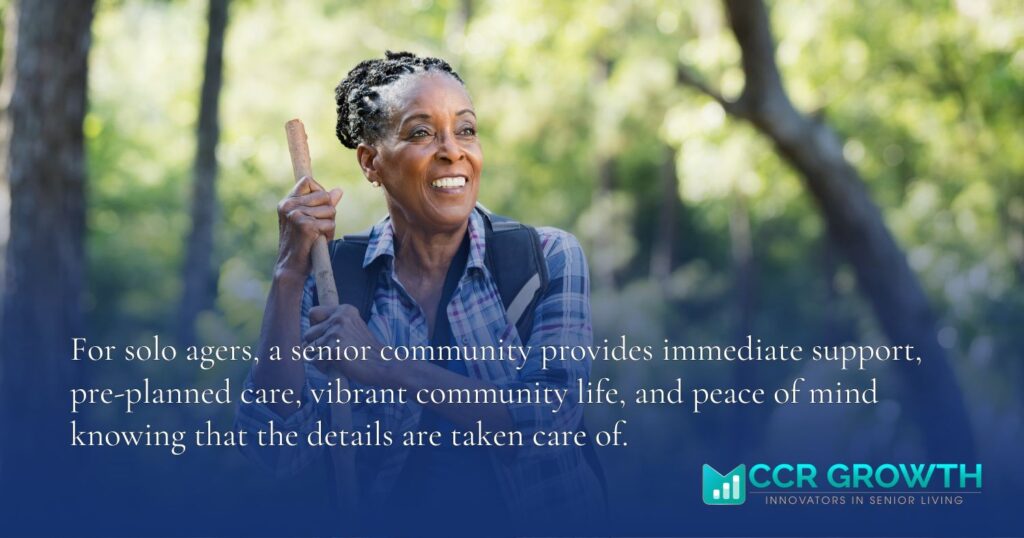
CCR Growth
How Senior Living Marketers Can Connect with the 'Solo Ager'
Key Takeaways
- Solo Agers are a Distinct Demographic: These older adults lack immediate family caregivers (children, extended family, few friends) and require unique consideration in senior living marketing and care.
- Aging Experience Differs: Solo agers often proactively plan for their future, prioritize independence and security, and act as their own primary decision-makers, unlike those with extensive family support.
- Senior Living is a Key Solution: Communities offer vital support systems for solo agers, providing immediate assistance, pre-planned care, social engagement, and peace of mind against isolation and emergency concerns.
- Marketing Requires a Unique Focus: Direct your marketing messages to empower solo agers, emphasizing autonomy, proactive planning, community connection, and professional expertise. They are the primary decision-makers.
- Prepare for Future Needs: Highlight your community’s ability to support solo agers through declining capabilities, offering a care continuum, honoring advance directives, and facilitating designated contacts for future decision-making.

In the evolving landscape of senior living, a distinct and growing demographic is emerging: the “solo ager”. These are older adults who don’t have adult children to rely on for support, and who might also lack extended family ties, as well as have dwindling friendships. This places this demographic at higher risk of social isolation and mental health issues, and means they are more vulnerable in an emergency, a prolonged illness, or simply navigating the later stages of life that may eventually require assistance.
Understanding solo agers isn’t just about recognizing their demographic profile; it’s about taking the time to truly grasp their point of view. Their journey into senior living, and indeed through their later years, is often marked by a proactive desire for independence, security, and community.
How the Solo Ager’s Aging Experience Differs
For many older adults, the aging process involves a network of adult children who assist with everything from managing appointments to making critical care decisions. Solo agers, however, navigate these waters differently. They are often highly organized, forward-thinking individuals who understand the importance of planning ahead for their future care needs. The absence of a traditional family caregiver network means they are often their own primary decision-makers, and they value control and self-determination above all else.
Their concerns might revolve around:
- Emergency contacts and support: Who will be there in a crisis?
- Long-term care planning: How will they ensure their wishes are met if they become incapacitated?
- Social isolation: How can they maintain a vibrant social life without immediate family nearby?
- Financial management: How can they safeguard their assets and ensure they have access to funds when needed?

Senior Living: A Solution for Solo Agers
Senior living communities are uniquely positioned to address the specific challenges faced by solo agers. Communities offer a built-in solution to many of their biggest concerns, providing a safe, stable, and supportive environment.
For solo agers, a community provides:
- Immediate Support: A professional staff available 24/7 for emergencies, medical needs, and daily assistance.
- Pre-Planned Care: The ability to establish a clear care plan and preferences in advance, offering immense peace of mind.
- Vibrant Community Life: Opportunities for social engagement, activities, and new friendships, combating potential loneliness.
- Peace of Mind: Knowing that details like meals, maintenance, and housekeeping are taken care of, allowing them to focus on enjoying life.
Ultimately, the senior living community provides the structure and services that a traditional family caregiver network might offer, all within a nurturing and engaging environment.
Marketing to the Solo Ager: A Unique Approach
From a marketing perspective, understanding the solo ager is critical. They aren’t just another segment; they are often the primary point of contact and decision-maker throughout the entire senior living process. This means your marketing efforts should directly address them and their specific concerns.

Consider these marketing angles:
- Empowerment and Control: Highlight how your community empowers residents to maintain independence and make choices about their care and lifestyle. Use phrases like “Your Future, Your Way.”
- Proactive Planning: Emphasize the benefits of planning ahead and the security that comes with having a comprehensive support system in place.
- Community and Connection: Showcase the vibrant social life, diverse activities, and opportunities for new friendships.
- Professional Expertise: Assure them of the highly trained staff, secure environment, and comprehensive care options available.
- Digital Accessibility: Many solo agers are digitally savvy; ensure your online presence is robust, easy to navigate, and provides clear information.
Content featuring testimonials from current solo ager residents, virtual tours, and detailed explanations of care coordination can be particularly effective. Your messaging should speak directly to their desire for autonomy and security.
Supporting Solo Agers Through Life’s Changes
A crucial aspect of supporting solo agers is understanding that, like all individuals, they may eventually face decreased capabilities or diseases like dementia. As marketers, we must subtly address how our communities are prepared for this.
This involves:
- Robust Care Continuum: Highlighting a seamless transition between independent living, assisted living, and memory care, ensuring continuous support.
- Advance Directives: Explaining how the community can assist in respecting and implementing their advance directives and wishes regarding care.
- Designated Contacts: Discussing processes for solo agers to designate trusted individuals (e.g., professional fiduciaries, close friends, or legal counsel) who can act on their behalf if they become incapacitated.
- Proactive Communication: Ensuring your teams are trained to observe changes and communicate proactively with designated contacts, ensuring timely and appropriate interventions.
By acknowledging these future possibilities and demonstrating comprehensive solutions, senior living communities build an even deeper level of trust with solo agers, showing them that choosing your community is not just a decision for today, but a robust plan for all their tomorrows.
Connecting with solo agers is about more than just filling beds; it’s about understanding and meeting the profound need for security, independence, and belonging as they write their next chapter. Get in touch with us at CCR Growth to learn how we can help you tailor your approach and truly connect with this important demographic.
Subscribe to our newsletter
Sharpen your expertise and stay ahead of senior living industry trends—subscribe to CCR Growth’s newsletter for exclusive insights and updates.
Recent Posts



A Complete Guide to Generative Engine Optimization for Senior Living
Redefining Senior Living Marketing, Sales, and Operations
CONTACT ADDRESS
8710 Carmel Valley Road, Carmel, CA 93923
GENERAL INQUIRIES
info@ccrgrowth.com
(831) 273-3628
SOCIAL MEDIA




